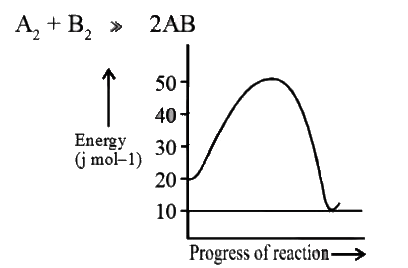Consider the following energy diagram for the reaction.
A2+B2?2AB

Column IColumn II(A)Ea(f)(P)−10 kJ mol−1(B)Ea(b)(Q)40 kJ mol−1(C)ΔHr(R)30 kJ mol−1(D)ET(S)50 kJ mol−1
The correct Answer is:A, B, C, D
Step by step video & image solution for Consider the following energy diagram for the reaction. A_(2)+B_(2) ? 2AB {:("Column I","Column II"),("(A)"E_(a)(f),"(P)"-10" kJ mol"^(-1)),("(B)"E_(a) (b), "(Q)" 40" kJ mol"^(-1)),("(C)" Delta H_(r), "(R)" 30" kJ mol"^(-1)),("(D)" E_(T),"(S)" 50" kJ mol"^(-1)):} by Chemistry experts to help you in doubts & scoring excellent marks in Class 12 exams.
Updated on:21/07/2023Topper's Solved these Questions
- Chemical KineticsBOOK - MOTIONCHAPTER - Chemical KineticsEXERCISE - Exercise - 2 (Level-II) (COMPREHENSION - 5)
1 Videos
- Chemical KineticsBOOK - MOTIONCHAPTER - Chemical KineticsEXERCISE - Exercise - 3
72 Videos
- Chemical KineticsBOOK - MOTIONCHAPTER - Chemical KineticsEXERCISE - Exercise - 2 (Level-II) (COMPREHENSION - 3)
4 Videos
- CHEMICAL EQUILIBRIUMBOOK - MOTIONCHAPTER - CHEMICAL EQUILIBRIUMEXERCISE - Exercise - 4
20 Videos
- CLASSROOM PROBLEMS BOOK - MOTIONCHAPTER - CLASSROOM PROBLEMS EXERCISE - Electrochemistry
22 Videos
Similar Questions
Calculate resonance energy of C6H6(g).
Given :Δf[C6H6(g)]=−360kJmol−1ΔHSub[C(graphite)]=716kJmol−1B.E.H−H=437kJmol−1B.E.C=C=620kJmol−1B.E.C−C=340kJmol−1B.E.C−H=490kJmol−1
View SolutionCalculate the lattice energy of the reaction
Li⊕(g)+CIΘ(g)→LiCI(s)
from the following data:
ΔsubHΘ(Li)=160.67kJmol−1,12D(CI2)=122.17kJmol−1IP(Li)=520.07kJmol−1,EA(CI)=−365.26kJmol−1 and ΔfHΘ(LiCI)=−401.66kJmol−1
View Solution
Knowledge Check
Match the bond enthalpies given in column II with the molecules given in column I and mark the appropriate choice.
Column IColumn II (A)Hydrogen (H2)(i)498.0 kJ mol−1(B)Oxygen(O2)(ii)946.0 kJ mol−1(C)Nitrogen(N2)(iii)435.8 kJ mol−1A(A)→(i),(B)→(ii),(C)→(iii)B(A)→(iii),(B)→(ii),(C)→(i)C(A)→(i),(B)→(iii),(C)→(ii)D(A)→(iii),(B)→(i),(C)→(ii)Efficiency of fuel is
(ΔG=700.3kJmol−1&ΔH=726kJmol−1)A66.2%B96.7%C41.3%D85.1%A→B,ΔH=−10KJmol−1,Ea(f)=50KJmol−1, then Ea of B→A will be
A40KJmol−1B50KJmol−1C−50KJmol−1D60KJmol−1
Calculate the resonance energy of gaseous benzene form the following data.
BE(C−H)=416.3kJmol−1
BE(C−C)=331.4kJmol−1
BE(C=C)=591.1kJmol−1
ΔsubHΘ(C,graphite)=718.4kJmol−1
ΔdissHΘ(H2,g)=435.9kJmol−1
ΔfHΘ(benzene,g)=82.9kJmol−1
View SolutionBased on the values of B.E. given, ΔfH∘ of N2H4 (g) is :
Given : N−N=159 kJ mol−1, H−H=436 kJ mol−1
N≡N=941 kJ mol−1, N−H=398 kJ mol−1
View SolutionWhat will be ΔH for the reaction,
CH2Cl2→C+2H+2Cl?
(B.E. of C−H and C−Cl bonds are 416 kJ mol−1 and 325 kJ mol−1 respectively)
View SolutionUsing the data provided, calculate the multiple bond energy (kJmol−1) of a C≡C bond in C2H2.That energy is (take the bond enrgy of a C-H bond as 350 kJ mol−1):
2C(s)+H2(g)→C2H2(g),ΔH=225kJmol−1
2C(s)→2C(g),ΔH=1410kJmol−1
H2(g)→2H(g),ΔH=330kJmol−1
View SolutionFollowing are the values of EaandΔH for three reactions carried out at the same temperature :
I:Ea=20kJmol−1,ΔH=−60kJmol−1
II:Ea=10kJmol−1,ΔH=−20kJmol−1
III:Ea=40kJmol−1,ΔH=+15kJmol−1
If all the three reaction have same frequency factor then fastest and slowest reactions are :
View Solution
